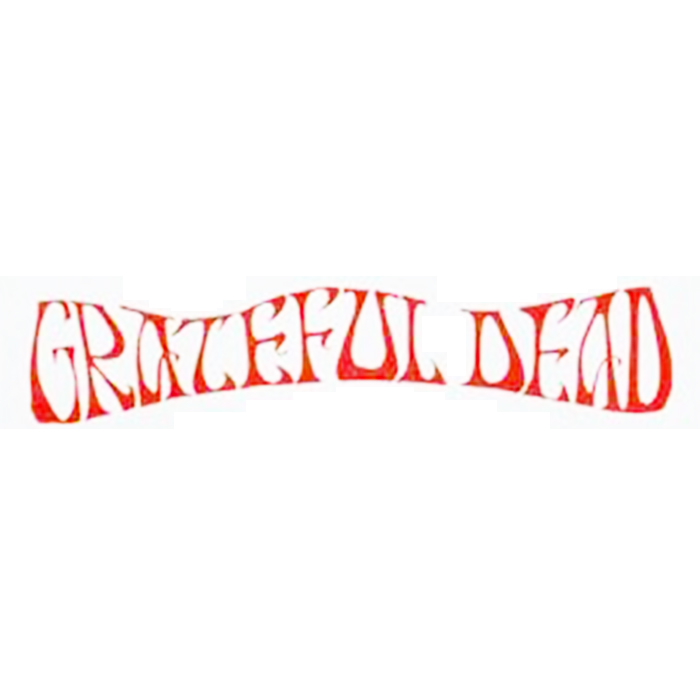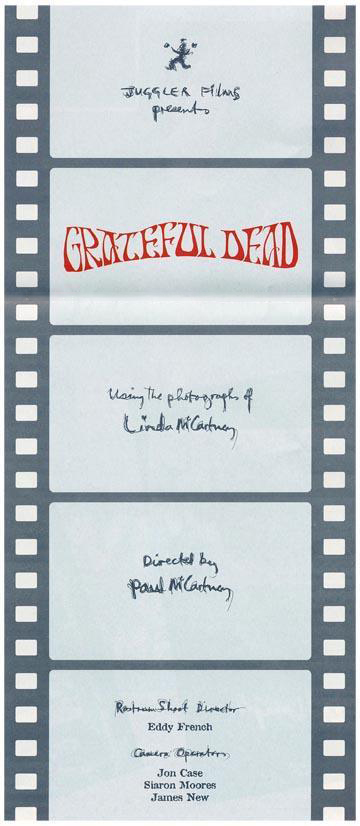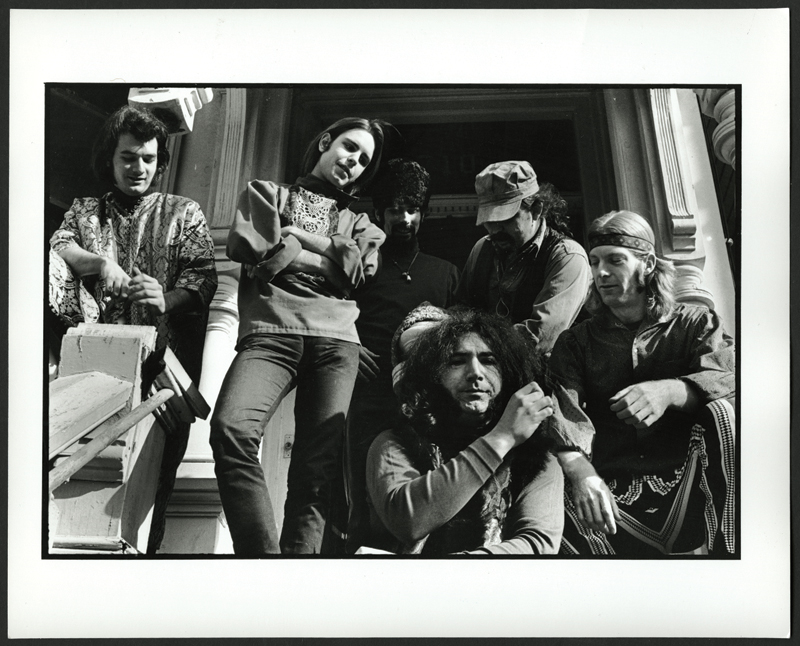
September 28-29, 1996
“Grateful Dead” photo film presented at the New York Film Festival
Last updated on February 8, 2022

September 28-29, 1996
Last updated on February 8, 2022
Location: New York Film Festival, New York, USA
Previous article July - September 1996 • BBC Proms 1996 - a message from Paul
Session Started Sep 16, 1996 • Recording "Heaven On A Sunday"
Session September 1996 • "Flaming Pie" sessions with Jeff Lynne at Hog Hill Mill #4
Article September 28-29, 1996 • "Grateful Dead" photo film presented at the New York Film Festival
Article Sep 30, 1996 • "Anthology 3" announced
Album Oct 28, 1996 • "Anthology 3" by The Beatles released globally
Paul and Linda McCartney’s short nine-minute film on the rock-group The Grateful Dead was presented at the two-day New York Film Festival. From The New York Times, September 26, 1996:
The latest project about the Grateful Dead is a film by an unlikely director: Paul McCartney. Not only is Mr. McCartney not known as a Deadhead, but he has never even seen the band perform live.
Speaking by telephone recently from his studio in Sussex, England, where he is recording a new solo album, Mr. McCartney said his interest was initially spurred not by a love for the band, but by a love for his wife’s photography. Using just four rolls of snapshots that Linda McCartney took of the Grateful Dead in the late 1960’s, Mr. McCartney has put together ”Grateful Dead: A Photofilm,” a short that will have its American premiere at the New York Film Festival on Saturday night, before the screening of Michelangelo Antonioni’s new movie, ”Beyond the Clouds,” and will then be repeated on Sunday. Afterward, Miramax, which released the film, will show it nationwide before selected showings of the films ”Trainspotting” and ”Microcosmos.”
”If Andy Warhol can film the Empire State Building for three hours, I figure I can do something with four rolls of film,” Mr. McCartney said.
Shot at the Grateful Dead House, the band’s communal home in Haight-Ashbury in San Francisco, and at a concert in Central Park, the nine-minute film is a moody, hypnotic piece, with titles and credits handwritten by Mr. McCartney. For the length of the film, music from the 1968 Grateful Dead album, ”Anthem of the Sun,” plays (with the vocals removed) as black-and-white photographs are juxtaposed, morphed into one another and put together like flip books so that band members seem to be moving. Other times, the camera slowly pans across faces in a magnified crowd photo, stopping at the most interesting character: a man in a trilby who looks like an undercover agent; a woman who seems to have consumed too many drugs.
Mr. McCartney said he thought of the idea while looking through a giant three-foot contact sheet of his wife’s photographs and feeling as he did when he was ill as a child and would stare at a newspaper photograph until he could imagine it moving. ”I noticed where she was trying to get a portrait of Bob Weir, she would take a whole roll of him, one photo after another,” he said of one band member. ”Of course, she only needed one shot, but in looking at the whole roll it looked like a movie. Your eyes almost ran it all together.”
Though the film has prompted some to accuse Mr. McCartney of cashing in on Jerry Garcia’s death last year, he said he had begun working on it long before then. ”I heard on the news that Jerry had died, and I thought, ‘Oh no, I was just about to show the film to him,’ ” Mr. McCartney said. ”I’d been in correspondence with him, because he was a painter and I thought he’d like this. Unfortunately, I missed him. I suppose it has become a little bit of a tribute to Jerry because of it.”
If Andy Warhol can film the Empire State Building for three hours, I figure I can do something with four rolls of film.
Paul McCartney
Before the New York Film Festival, the short film had been shown at smaller events during the previous months.
Paul McCartney’s ten-minute short film, The Grateful Dead – A Photofilm, will be showing at selected film festivals around the world in the coming months, having already been screened at little-publicised events in Canada, Poland, Germany, Finland and Britain (it appeared here, without fanfare, in March). Overseas readers can catch Paul’s pioneering art-movie in Villa Diconde in Portugal during July, and in Brisbane, Australia in August. Venues and times were unavailable at our press time, so check local publications for more details.
From The Beatles Monthly, N° 243, 1996

From Club Sandwich N°75:
With Paul McCartney one comes to expect the unexpected. Suddenly, there he is, shielding his eyes from the bright Soho sunshine, stepping out of a darkened edit suite with a film can tucked underneath his arm. It has been a labour-of-love production and, for two years, a secret one. Now it’s ready to hit the screen: Grateful Dead – A Photofilm.
But why is Paul making a film about the Grateful Dead, you might ask. Well, why not? Paul and Linda have long been Dead-heads (journalists thought Paul was joking when he was asked if the Rolling Stones had inspired him to go back on the road in 1989 and he replied “No, it was the Grateful Dead”) and the film is definitely a husband and wife affair: her photographs, his muse.
Grateful Dead – A Photofilm is a short art-film, running 9 minutes 17 seconds, but it’s the result of painstaking effort. Indeed, only one thing about it is simple, and that’s the premise: Linda’s 1960s photographs of the band, some taken in Central Park, New York, the others in Haight-Ashbury, San Francisco, have been turned into moving images. In other words, it’s an action film made from stills. Very effectively.
It’s been done so well, in fact, that one is left with the impression that one is watching a moving film that has been freeze-framed.
Further advancing Paul’s long-held interest in cinematographic art, Grateful Dead – A Photofilm took life during the New World Tour in 1993. With time to spare, Paul hit upon the idea while scanning through some of Linda’s pictures. “When I was a kid, recovering from an illness,” he recalls, “I had a strange experience when, by concentrating on a photograph in a newspaper, I seemed to be able to make it move. Looking at Linda’s pictures of the Grateful Dead I got that feeling again, that maybe I could make them into a film. Especially as they capture a time when not much footage exists of the band.” Still on tour, Paul asked for certain experimental processes to be implemented onto film which he then looked at and (no pun intended) began to develop.
In all, Linda had shot four 36-exposure 35mm black-and-white rolls, meaning that there were 144 images of the Dead available for what Paul began to call a Photofilm. All 144 were used as he assembled the 5×4-inch prints into a sequence that pleased him and then set about the job of storyboarding them – compiling what he came to call “a grocery list” of progressive ideas. Using a variety of styles, speeds and angles, the photographs were then shot by a Rostrum camera, creating many hours of raw uncut moving film.
Paul then chose the music tracks, exercising his familiarity with the Dead’s work to select excerpts from three numbers – ‘That’s It For The Other One’, ‘New Potato Caboose’ and ‘Alligator’ – that perfectly align with the images. Because everything about Grateful Dead – A Photofilm is authentic, even the applause heard as accompaniment to the Central Park concert stills has been taken from one of the band’s concerts at that time. “Truly,” says Robby Montgomery, Paul and Linda’s co-producer on the Photofilm, “the attention to detail throughout the whole film has been painstaking. It’s a total act of love, not something done for commercial purposes or with a specific release date in mind.”
Robby has worked with Paul and Linda for many years, principally as Linda’s photography agent, and he is quick to remind us of her role. “For a start,” he says, “Linda has always been smart enough to keep her negatives, and to look after them. A lot of photographers in the 1960s didn’t do so. The negatives are 30 years old, but when they’re blown up they’re still remarkably clear and you can see incredible things which just weren’t thought about at the time. Take, for example, the Central Park concert. Primarily, Linda was photographing the band, but now one can see so much else going on, and the faces in the crowd come alive. The stills really capture the inter-reaction between the band and the audience, picking up on the atmosphere.”
Linda’s technique as a photographer also merits Robby’s praise. “These stills of the Grateful Dead were taken before motor-drive cameras were popular,” he considers, “yet she took some of the photographs in a clear sequence, particularly a series of portraits of [guitarist] Bob Weir which are ideal for turning into moving action, even though, obviously, she wasn’t thinking at the time of having this done.”
Paul’s storyboarding of the 144 images and the miles of film that resulted from the Rostrum camera work was but the start of a major operation. Into the Soho editing suite went Paul, often for a mentally-draining 10-12 hours a day that, depending on the trickiness of the work that entailed, might yield as “much” as two minutes of completed film or as little as 30 seconds. Either way, Paul did not shrink from the task, remaining very much hands-on for the entire duration. Fortunately, in Eddy French, he found an editor as willing to put in the hours as he was ^sympathetic to his objective.
And what was Paul’s objective? “To make a film that he was artistically happy with,” says Robby. “Anyone can take stills and turn them it into an MTV-style promo, but Grateful Dead – A Photofilm is a pure art film. There were no deadlines or corporate pressures exerted on him, so, quite simply, the film was not finished until Paul was happy with it. Such care was made – for example, it was decided to put scratches on to the film, as if it had been sitting in a can for 30 years and had deteriorated, and we had meetings where we discussed the kind of scratches we should add. On a conscious level the viewer may not even notice them but they still have to be right. Paul is a perfectionist and he instinctively knows when something is right or not. He worked at it until it was.”
As a result of this supreme dedication Grateful Dead — A Photofilm has been accepted into the 39th London Film Festival, being held 2-19 November. The festival’s prime objective is the promotion of cinematographic art, presenting films of an extremely high standard, so although it gives out no awards the very fact that the Grateful Dead film has been accepted is prize enough. Not that Paul’s name has had anything to do with this: the film has admitted on merit alone. “It happens to be an extremely good film,” confirms Robby, “and I have been specifically informed, quote unquote, that it would have gotten into the London Film Festival whether or not it was made by Paul McCartney. So it’s really quite an achievement.”
As Grateful Dead – A Photofilm moves on from London to other festivals at home and abroad, so Robby Montgomery expects to see its innovative technique “lifted” by others. “There are certain aspects of this film which are highly original,” he says, “and you can bet your bottom dollar that the hip people out there, the 10 per cent that start all the trends, will pick up ideas from it and turn them into adverts for Levi’s or whoever. Certainly, from the few people who have seen it so far, we are already getting calls asking how it was done, so that the techniques can be used for other projects.”
Sadly, in August, since the completion of Paul’s film, Jerry Garcia, the leader of the Grateful Dead, passed away. “People should be clear that we are not in any way trying to profit from or capitalise on Jerry death,” assures Robby. “Paul has been working on this for two years now, and it had already been accepted into the London Film Festival before Jerry died. If anything, it’ll serve as a tribute to Jerry. The thing is, films such as this can only do good. And there’s so much bad going on in the world that it’s great to be able to do something which only produces happiness and only makes you feel good.” It makes one feel so good, in fact, that already another project is in the pipeline: Paul is planning to take Linda’s stills of the Beatles and turn them into a Photofilm. If it’s as good as the Grateful Dead one, and there’s no reason why it shouldn’t be, then it’s a mouth-watering prospect indeed.

From The Beatles Monthly N°249, January 1997:
Paul’s debut photofilm, the nine-minute Ihe Grateful Dead, has received further screening in America recently. lt received its premiere at the New York Film Festival, over 28th and 29th September, and was also shown as a supporting picture to the film Trainspotting, and at the Angelika Film Centre in New York on 11th October. Additional screenings took place in cinemas in Santa Monica and San Francisco. The film was also shown as support for a different film, Microcosmos, in Los Angeles.
The Beatles Diary Volume 2: After The Break-Up 1970-2001
"An updated edition of the best-seller. The story of what happened to the band members, their families and friends after the 1970 break-up is brought right up to date. A fascinating and meticulous piece of Beatles scholarship."
We owe a lot to Keith Badman for the creation of those pages, but you really have to buy this book to get all the details - a day to day chronology of what happened to the four Beatles after the break-up and how their stories intertwined together!
The Beatles - The Dream is Over: Off The Record 2
This edition of the book compiles more outrageous opinions and unrehearsed interviews from the former Beatles and the people who surrounded them. Keith Badman unearths a treasury of Beatles sound bites and points-of-view, taken from the post break up years. Includes insights from Yoko Ono, Linda McCartney, Barbara Bach and many more.

Notice any inaccuracies on this page? Have additional insights or ideas for new content? Or just want to share your thoughts? We value your feedback! Please use the form below to get in touch with us.
Max • 4 years ago
Would love to see Paul’s “Grateful Dead: A Photofilm“
The PaulMcCartney Project • 4 years ago
Hi Max, me too ! I've been unable to find it on the web, or anywhere else ...
C • 2 years ago
Where can this be seen, in 2022?
The PaulMcCartney Project • 2 years ago
Hi C, I've still not been able to locate it.
r • 2 years ago
someone throw it up on a tracker, baby!
Mitya Sizikov • 1 year ago
It was part of Wide Prairie Webcast in 1998, you can find in on YouTube
The PaulMcCartney Project • 1 year ago
Ah thanks for that tip, Mitya !
fan • 1 year ago
The PaulMcCartney Project • 1 year ago
Thanks very much sharing this video, @fan ! So much time I wanted to see it !